
Your facility’s crash cart could be accessed at any time for a staff or patient medical emergency. But have you taken steps to ensure your crash cart is stocked and ready for any emergency? Do you know what medications and equipment should be available on the crash cart?
This article will review a possible list of crash cart supplies, as well as recommendations to help facilities ensure the readiness of their crash carts and avoid safety issues.
The Crash Cart Supply List
The authors of a review article published in the World Journal of Emergency Medicine (WJEM) reported that there are no clear guidelines for stocking crash carts. Crash carts – or code cards – must contain the equipment needed for a facility to respond to a staff or patient medical emergency, but the contents and organization of crash carts will vary depending on the unit and its patient population.
Based on standard resuscitation algorithms, the WJEM researchers suggested a 5-drawer cart system that would be adequate for most patient or staff emergencies. The first three drawers of the crash cart are small, followed by two progressively larger drawers.
The Outside of the Code Cart
All crash cart contents should be listed on an attached laminated sheet or card, including expiration dates where applicable. Attached to the front of each drawer should be a laminated alphabetical list of the drawer’s contents. In addition to the supplies listed below, a portable suction machine should be available on the crash cart.
The WJEM researchers suggested that the following supplies be kept on or attached to the cart, in clear bags where appropriate:
- Defibrillator
- Infant paddles, cables, and pads
- Adult Ambu bag with size 3 and 4 facemasks
- Oxygen tube connector in clear bag
- Infant and child Ambu bags with size 1 and 2 facemasks and an oxygen tube connector
- Oxygen tank
- CPR backboard
- Laminated Broselow (or similar) pediatric emergency tape
Drawer 1
The top drawer, or drawer 1, should contain emergency medications with the most commonly used medications located in the front of the drawer. The WJEM researchers suggested using divided compartments to keep code cart medications organized according to their use.
When storing medications, consider that some meds are sensitive to light and should be stored in an opaque, labeled container. Medications with similar names should be clearly marked and stored separately to avoid user error.
The ACLS Training Center recommends that the following medications be included on crash carts:
Cardiac arrest medications:
- Amiodarone
- Epinephrine
Medications for treating heart arrhythmias:
- Adenosine
- Atropine
- Diltiazem
- Lopressor or another beta blocker
Medications to treat allergic reactions:
- Epipens for adult and pediatric patients
- Methylprednisolone
- Diphenhydramine
Other medications:
- Aspirin
- Nitroglycerin tablets or spray
- Narcan
- Procainamide
- Lidocaine
- Dextrose
Drawer 2
The second drawer holds additional adult medications, pediatric medications, and IV fluids. Place pediatric medications in a separate tray or transparent bag that is clearly labeled.
Drawer 3
The third drawer in the code cart is used to store intravenous supplies, such as IV catheters, alcohol wipes, tape, tubing, and syringes. This drawer can also hold emergency pneumothorax and pericardiocentesis supplies, arterial line catheters, a magnet for resetting pacemakers or defibrillators, and nasal packs.
Drawer 4
This larger drawer stores intubation and respiratory equipment. Adult and pediatric supplies should be kept in separate compartments that can be pulled out and placed at the head of the bed.
Drawer 5
The largest drawer in the code cart is the procedure drawer, housing supplies such as chest tubes, central venous catheters, intraosseous kits, a cut-down tray, an umbilical cath kit, a suture set, a delivery set, and tourniquets.
Recommendations to Avoid Safety Issues
A crash cart can fail to consistently meet the needs of emergency situations if the facility does not have a system in place for cart checks and restocking. The Joint Commission’s 2017 crash-cart preparedness document recommends that facilities use a web-based or other standardized system to track carts, usage, checks and expiration dates.
Based on successful crash cart systems already in use in facilities, the Joint Commission made the following recommendations to reduce safety issues:
- Use sealed trays to easily identify trays that need to be replaced
- Ensure that trained staff perform regular cart checks and restock carts promptly
- Keep crash carts in easy to access locations
- Clearly arrange and label crash cart contents
- Keep pediatric and adult medications separated
- Attach checklists and reference documents to the cart
- Provide staff with regular mock codes and continuing education on the contents and use of crash carts
- Consider keeping cart checks simple by removing unnecessary items and standardizing the organization of the crash cart’s contents.
The Joint Commission understands the need to balance accessibility with security. Plastic breakaway locks, as opposed to cumbersome padlocks, provide fast access and alert staff to a cart that requires restocking.
Avoid patient safety issues and be prepared for patient and staff emergencies by investing time in preparing a standardized protocol for stocking, checking, and restocking your facility’s crash carts.

Cindy Blye
Content WriterCindy Blye, BSN, RN, CCM is a Registered Nurse and Certified Case Manager. She is an Alumni of West Virginia University School of Nursing (BSN), and a member of the Association of Health Care Journalists and The Authors Guild.
